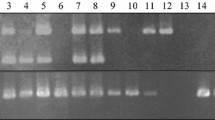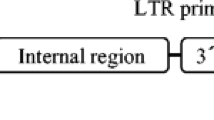Abstract
We have developed a display system using a unique sequence of terminal repeat retrotransposon in miniature (TRIM) elements, which were recently identified from gene-rich regions of Brassica rapa. The technique, named TRIM display, is based on modification of the AFLP technique using an adapter primer for the restriction fragments of BfaI and a primer derived from conserved terminal repeat sequences of TRIM elements, Br1 and Br2. TRIM display using genomic DNA produced 50–70 bands ranging from 100 to 700 bp in all the species of the family Brassicaceae. TRIM display using B. rapa cDNA produced about 20 bands. Sequences of 11 randomly selected bands, 7 from genomic DNA and 4 from cDNA, begin with about 104 bp of the terminal repeat sequences of TRIM elements Br1 or Br2 and end with unique sequences indicating that all bands are derived from unique insertion sites of TRIM elements. Furthermore, 7 of the 11 unique sequences showed significant similarity with expressed gene. Most of the TRIM display bands were polymorphic between genera and about 55% (132 of 239 bands) are polymorphic among 19 commercial F1 hybrid cultivars. Analysis of phylogenetic relationships shows clear-cut lineage among the 19 cultivars. Furthermore, a combination of 11 polymorphic bands derived from only one primer combination can clearly distinguish one cultivar from the others. TRIM display bands were reproducible and inheritable through successive generations that is revealed by genetic mapping of 6 out of 27 polymorphic TRIM markers on the genetic map of Brassica napus. Collective data provide evidence that TRIM display can provide useful DNA markers in Brassica relatives because these markers are distributed in gene-rich regions, and are sometimes involved in the restructuring of genes.





Similar content being viewed by others
References
Anderson JA, Chhrchill GA, Autrigue JE, Tanksley SD (1993) Optimizing parental selection for genetic linkage map. Genome 36:181–186
Bennetzen JL (2005) Transposable elements, gene creation and genome rearrangement in flowering plants. Curr Opin Genet Dev 15:621–627
Blanc G, Wolfe KH (2004) Widespread paleopolyploidy in model plant species inferred from age distributions of duplicate genes. Plant Cell 16: 1667–1678
Bureau TE, Wessler SR (1994) Mobile inverted-repeat elements of the Tourist family are associated with the genes of many cereal grasses. Proc Natl Acad Sci USA 91:1411–1415
Casa AM, Bruwer C, Nagel A, Wang L, Zhang Q, Kresovich S, Wessler SR (2000) The MITE family Heartbreaker (Hbr): molecular markers in maize. Proc Natl Acad Sci USA 97:10083–10089
Casa AM, Mitchell SE, Smith OS, Register III JC, Wessler SR, Kresovich S (2002) Evaluation of Hbr (MITE) markers for assessment of genetic relationships among maize (Zea mays L.) inbred lines. Theor Appl Genet 104:104–110
Ellis THN, Poyser SJ, Knox MR, Vershinin AV, Ambrose MJ (1998) Polymorphism of insertion sites of Ty1-copia class retrotransposons and its use for linkage and diversity analysis in pea. Mol Gen Genet 60:9–19
Fedoroff N (2000) Transposons and genome evolution in plants. Proc Natl Acad Sci USA 97: 7002–7007
Fourman M, Bareet P, Froger N, Baron C, Charlot F, Delourme R, Brunel D (2002) From Arabidopsis thaliana to Brassica napus: development of amplified consensus genetic markers (ACGM) for construction of a gene map. Theor Appl Genet 105:1196–1206
Garber K, Bilic I, Pusch O, Tohme J, Bachmair A (1999) The Tpv2 family of retrotransposons of Phaseolus vulgaris: structure, integration characteristics, and use for genotype classification. Plant Mol Biol 39:797–807
Gribbon BM, Pearce SR, Kalendar R, Schulman AH, Paulin L, Jack PL, Kumar A, Flavell AJ (1999) Phylogeny and transpositional activity of Ty1-copia group retrotransposons in cereal genomes. Mol Gen Genet 261:883–891
Hirochika H, Otsuki H, Yoshikawa M, Otsuki Y, Sugimoto K, Takeda S (1996) Autonomous transposition of the tobacco retrotransposon Tto1 in rice. Plant Cell 8:725–734
Hurles M (2004) Gene duplication: the genomic trade in spare parts. PLoS Biol 2:900–904
Jang I, Moon JH, Yoon JB, Yoo JH, Yang TJ, Kim YJ, Park HG (2004) Application of RAPD and SCAR markers for purity testing of F1 hybrid seed in chili pepper (Capsicum annuum). Mol Cells 18:295–299
Jiang N, Bao Z, Temnykh S, Cheng Z, Jiang J, Wing R, McCouch S, Wessler SR (2002) Dasheng: a recently amplified nonautonomous LTR element that is a major component of pericentromeric regions in rice. Genetics 161:1293–1305
Kentner EK, Arnold ML, Wessler SR (2003) Characterization of high-copy-number retrotransposons from the large genome of the Louisiana iris species and their use as molecular markers. Genetics 164:685–697
Kumar A, Bennetzen JL (1999) Plant retrotransposons. Annu Rev Genet 33:479–532
Leigh F, Kalendar R, Lea V, Lee D, Donini P, Schulman AH (2003) Comparison of the utility of barley retrotransposon families for genetic analysis by molecular marker technique. Mol Gent Genomics 269:464–474
Lim KB, de Jong H, Yang TJ, Park JY, Kwon SJ, Kim JS, Lim MH, Kim JA, Jin M, Jin YM, Kim SH, Lim YP, Bang JW, Kim HI, Park BS (2005) Characterization of rDNA and tendom repeats in the heterochromatin of Brassica rapa. Mol Cells 19:436–444
Lysak MA, Koch MA, Pecinka A, Schubert I (2005) Chromosome triplication found across the tribe Brassicaceae. Genome Res 15:516–525
Maere S, De Bodt S, Raes J, Casneuf T, Van Montagu M, Kuiper M, Van de Peer Y (2005) Modeling gene and genome duplications in eukaryotes. Proc Natl Acad Sci USA 102:5454–5459
Margaret G, Kidwell, Damon Lisch (1997) Transposable elements as sources of variation in animals and plants. Proc Natl Acad Sci USA 94:7704–7711
Miyao A, Tanaka K, Murata K, Sawaki H, Takeda S, Abe K, Shinozuka Y, Onosata K, Hirochika H (2003) Target site specificity of the Tos17 retrotransposon shows a preference for insertion within genes and against insertion in retrotransposon-rich regions of the genome. Plant Cell 15:1771–1780
Nei M, Li WH (1979) Mathematical model for studying genetic variation in terms of restriction endonucleases. Proc Natl Acad Sci USA 76:5269–5273
Panaud O, Chen X, McCouch SR (1996) Development of microsatellite markers and characterization of simple sequence length polymorphism (SSLP) in rice (Oryza sativa L.). Mol Gen Genet 252:597–607
Park JY, Koo DH, Hong CP, Lee SJ, Jeon JW, Lee SH, Yun PY, Park BS, Kim HR, Bang JW, Plaha P, Bancroft I, Lim YP (2005) Physical mapping and microsynteny of Brassica rapa ssp. pekinensis genome corresponding to a 222 kb gene-rich region of Arabidopsis chromosome 4 and partially duplicated on chromosome 5. Mol Gen Genomics 274:579–588
Pearce SR, Stuart-Rogers C, Kumar A, Flavell AJ (1999) Rapid isolation of plant Ty-1 copia group retrotransposons LTR sequences for molecular marker studies. Plant J 19:1–7
Pearce SR, Knox M, Ellis THN, Flavell AJ, Kumar A (2000) Pea Ty1-copia group retrotransposons: transposition activity and use as markers to study genetic diversity in Pusum. Mol Gen Genet 263:898–907
Porceddu A, Albertini E, Baracaccia G, Marconi G, Bertoli FB, Veronesi F (2002) Development of S-SAP markers based on an LTR-like sequence from Medicago sativa L. Mol Gen Genet 267:107–114
Prieto JL, Pouilly N, Jenczewski E, Deragon JM, Chevre AM (2005) Development of crop-specific transposable element (SINE) markers for studying gene flow from oilseed rape to wild radish. Theor Appl Genet 111:446–455
Purugganan MD, Wessler SR (1995) Transposon signatures: species-specific molecular markers that utilize a class of multiple-copy nuclear DNA. Mol Ecol 4:265–269
Qiu D, Morgan C, Shi J, Long Y, Liu J, Li R Zhuang Y, Wang Y, Tan X, Dietrich E, Weihmann T, Everett C, Vanstraelen S, Beckett P, Fraser F, Trick M, Barnes S, Wilmer J, Schmidt R, Li J, Li D, Meng J, Bancroft I (2006) A comparative linkage map of oilseed rape and its use for QTL analysis of seed oil and erucic acid content. Theor Appl Genet 114:67–80
Queen RA, Gribbon BM, James C, Jack P, Flavell AJ (2004) Retrotransposon-based molecular markers for linkage and genetic diversity analysis in wheat. Mol Gen Genomics 271:91–97
Rana D, van de Boogaart T, O’Neill CM, Hynes L, Bent E, Macpherson L, Park JY, Lim YP, Bancroft I (2004) Conservation of the microstructure of genome segments in Brassica napus and it’s diploid relatives. Plant J 40:725–733
Schulman AH, Flavell AJ, Ellis THN (2004) The application of LTR retrotransposons as molecular markers in plants. In: Miller WJ, Capy P (eds) Mobile genetic elements protocols and genetic applications. Humana Press, Totawa, pp 145–174
Tam SM, Mhiri C, Vogelaar A, Kerkveld M, Pearce SR Grandbastien M (2005) Comparative analyses of genetic diversities within tomato and pepper collections detected by retrotransposon-based SSAP, AFLP and SSR. Theor Appl Genet 110:819–831
The Rice Chromosome 10 Sequencing Consortium et al (2003) In-depth view of structure, activity, and evolution of rice chromosome 10. Science 30:1566–1569
The Rice Chromosome 3 Sequencing Consortium (2005) Sequence, annotation, and analysis of synteny between rice chromosome 3 and diverged grass species. Genome Res 15:1284–1291
Vos P, Hogers K, Bleeker M, Reijans M, van de Lee T, Hornes M, Frijters BA, Pot J, Peleman J, Kuiper M, Zabeau M (1995) AFLP: a new technique for DNA fingerprinting. Nucleic Acids Res 23:4407–4414
Waugh R, Melean K, Flavell AJ (1997) Genetic distribution of Bare-1-like retrotransposable elements in the barley genome revealed by sequence-specific amplification polymorphism (S-SAP). Mol Gen Genet 253:687–694
Wessler SR, Bureau TE, White SE (1995) LTR-retrotransposons and MITEs: important players in the evolution of plant genomes. Curr Opin Genet Dev 5:814–21
White SE, Harbera LF, Wessler SR (1994) Retrotransposons in the flanking regions of plant genes-a role for copia-like elements in the evolution of gene structure and expression. Proc Natl Acad Sci USA 91:11792–11796
Witte CP, Le QH, Bureau TE, Kumar A (2001) Terminal-repeat retrotransposons in miniature (TRIM) are involved in restructuring plant genomes. Proc Natl Acad Sci USA 98: 13778–13783
Yang TJ, Kim JS, Lim KB, Kwon SJ, Kim JI, Jin M, Park JY, Lim MH, Kim HI, Kim SH (2005a) The Korea Brassica Genome Project: A glimpse of the Brassica genome based on comparative genome analysis with Arabidopsis. Comp Funct Genomics 6:138–146
Yang TJ, Lee S, Chang SB, Yu Y, de Jong H, Wing RA (2005b) In-depth sequence analysis of the tomato chromosome 12 centromeric region: identification of a large CAA block and characterization of pericentromere retrotransposons. Chromosoma 14:103–117
Yang TJ, Kim JS, Kwon SJ, Choi BS, Lim KB, Kim JI, Jin M, Park JY, Lim MH, Kim HI (2006) Sequence-level analysis of the triplicated Flowering Locus C region of Brassica rapa. Plant Cell 18:1339–1347
Yang TJ, Kwon SJ, Kim JS, Jin M, Lim KB, Park JY, Kim JA, Lim MH, Kim HI, Lee HJ, Choi BS, Lim YP, Paterson AH, Park BS (2007) Characterization of terminal-repeat retrotransposon in miniature (TRIM) in Brassica relatives. Theor Appl Genet 114:627–636
Zhao J, Wang X, Deng B, Lou P, Wu J, Sun R, Xu Z, Vromans J, Koornneef M, Bennema G (2005) Genetic relationship within Brassica rapa as inferred from AFLP fingerprints. Theor Appl Genet 110:1301–1314
Acknowledgments
This work was partly supported by a grant from the BioGreen 21 Program (20050301034438), Rural Development Administration, and the National Institute of Agricultural Biotechnology (04-1-12-2-4), Korea. We thank Dawn Holligan for technical advice and assistance.
Author information
Authors and Affiliations
Corresponding authors
Additional information
Communicated by M.-A. Grandbastien.
GenBank accession nos.: AC190326 (TRIM display fragment gCP01); AC190327 (TRIM display fragment gCP02); AC190328 (TRIM display fragment gCP02) AC190329 (TRIM display fragment gCP04) AC190330 (TRIM display fragment gDP01); AC190331 (TRIM display fragment gDP02); AC190332 (TRIM display fragment gDP03); AC190333 (TRIM display fragment gDP04); AC190334 (TRIM display fragment gDP05); AC190335 (TRIM display fragment gDP06); AC190336 (TRIM display fragment gDP07).
Electronic supplementary material
Below is the link to the electronic supplementary material.
Rights and permissions
About this article
Cite this article
Kwon, SJ., Kim, DH., Lim, MH. et al. Terminal repeat retrotransposon in miniature (TRIM) as DNA markers in Brassica relatives. Mol Genet Genomics 278, 361–370 (2007). https://doi.org/10.1007/s00438-007-0249-6
Received:
Accepted:
Published:
Issue Date:
DOI: https://doi.org/10.1007/s00438-007-0249-6




